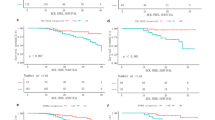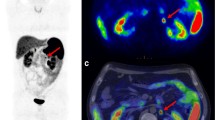Abstract
Objectives
This study aims to develop and validate a radiomics model based on 18F-fluorodeoxyglucose positron emission tomography–computed tomography ([18F]FDG PET-CT) images to predict pathological complete response (pCR) to neoadjuvant chemoimmunotherapy in non-small cell lung cancer (NSCLC).
Materials and methods
One hundred eighty-five patients receiving neoadjuvant chemoimmunotherapy for NSCLC at 5 centers from January 2019 to December 2022 were included and divided into a training cohort and a validation cohort. Radiomics models were constructed via the least absolute shrinkage and selection operator (LASSO) method. The performances of models were evaluated by the area under the receiver operating characteristic curve (AUC). In addition, genetic analyses were conducted to reveal the underlying biological basis of the radiomics score.
Results
After the LASSO process, 9 PET-CT radiomics features were selected for pCR prediction. In the validation cohort, the ability of PET-CT radiomics model to predict pCR was shown to have an AUC of 0.818 (95% confidence interval [CI], 0.711, 0.925), which was better than the PET radiomics model (0.728 [95% CI, 0.610, 0.846]), CT radiomics model (0.732 [95% CI, 0.607, 0.857]), and maximum standard uptake value (0.603 [95% CI, 0.473, 0.733]) (p < 0.05). Moreover, a high radiomics score was related to the upregulation of pathways suppressing tumor proliferation and the infiltration of antitumor immune cell.
Conclusion
The proposed PET-CT radiomics model was capable of predicting pCR to neoadjuvant chemoimmunotherapy in NSCLC patients.
Clinical relevance statement
This study indicated that the generated 18F-fluorodeoxyglucose positron emission tomography–computed tomography radiomics model could predict pathological complete response to neoadjuvant chemoimmunotherapy, implying the potential of our radiomics model to personalize the neoadjuvant chemoimmunotherapy in lung cancer patients.
Key Points
• Recognizing patients potentially benefiting neoadjuvant chemoimmunotherapy is critical for individualized therapy of lung cancer.
• [18F]FDG PET-CT radiomics could predict pathological complete response to neoadjuvant immunotherapy in non-small cell lung cancer.
• [18F]FDG PET-CT radiomics model could personalize neoadjuvant chemoimmunotherapy in lung cancer patients.




Similar content being viewed by others
Abbreviations
- [18F]FDG PET-CT:
-
18F-fluorodeoxyglucose positron emission tomography–computed tomography
- AUC:
-
Area under curve
- GSEA:
-
Gene set enrichment analysis
- ICC:
-
Intraclass correlation coefficients
- IDI:
-
Integrated discrimination improvement
- LASSO:
-
Least absolute shrinkage and selection operator
- NRI:
-
Net reclassification improvement
- NSCLC:
-
Non-small cell lung cancer
- pCR:
-
Pathological complete response
- ROC:
-
Receiver operating characteristic curve
- ssGSEA:
-
Single sample gene set enrichment analysis
- SUVmax:
-
Maximum standardized uptake value
References
Forde PM, Chaft JE, Smith KN et al (2018) Neoadjuvant PD-1 blockade in resectable lung cancer. N Engl J Med 378:1976–1986
Shu CA, Gainor JF, Awad MM et al (2020) Neoadjuvant atezolizumab and chemotherapy in patients with resectable non-small-cell lung cancer: an open-label, multicentre, single-arm, phase 2 trial. Lancet Oncol 21:786–795
Provencio M, Nadal E, Insa A et al (2020) Neoadjuvant chemotherapy and nivolumab in resectable non-small-cell lung cancer (NADIM): an open-label, multicentre, single-arm, phase 2 trial. Lancet Oncol 21:1413–1422
Gao S, Li N, Gao S et al (2020) Neoadjuvant PD-1 inhibitor (sintilimab) in NSCLC. J Thorac Oncol 15:816–826
Forde PM, Spicer J, Lu S et al (2022) Neoadjuvant nivolumab plus chemotherapy in resectable lung cancer. N Engl J Med 386:1973–1985
Kaira K, Higuchi T, Naruse I et al (2018) Metabolic activity by (18)F-FDG-PET/CT is predictive of early response after nivolumab in previously treated NSCLC. Eur J Nucl Med Mol Imaging 45:56–66
Pellegrino S, Fonti R, Mazziotti E et al (2019) Total metabolic tumor volume by 18F-FDG PET/CT for the prediction of outcome in patients with non-small cell lung cancer. Ann Nucl Med 33:937–944
Seban RD, Mezquita L, Berenbaum A et al (2020) Baseline metabolic tumor burden on FDG PET/CT scans predicts outcome in advanced NSCLC patients treated with immune checkpoint inhibitors. Eur J Nucl Med Mol Imaging 47:1147–1157
Cascone T, Weissferdt A, Godoy MCB et al (2021) Nodal immune flare mimics nodal disease progression following neoadjuvant immune checkpoint inhibitors in non-small cell lung cancer. Nat Commun 12:5045
Tao X, Li N, Wu N et al (2020) The efficiency of (18)F-FDG PET-CT for predicting the major pathologic response to the neoadjuvant PD-1 blockade in resectable non-small cell lung cancer. Eur J Nucl Med Mol Imaging 47:1209–1219
Zhuang F, Haoran E, Huang J et al (2023) Utility of (18)F-FDG PET/CT uptake values in predicting response to neoadjuvant chemoimmunotherapy in resectable non-small cell lung cancer. Lung Cancer 178:20–27
Zhong Y, She Y, Deng J et al (2022) Deep learning for prediction of N2 metastasis and survival for clinical stage I non-small cell lung cancer. Radiology 302:200–211
Gu Y, She Y, Xie D et al (2018) A texture analysis-based prediction model for lymph node metastasis in stage IA lung adenocarcinoma. Ann Thorac Surg 106:214–220
Cong M, Feng H, Ren JL et al (2020) Development of a predictive radiomics model for lymph node metastases in pre-surgical CT-based stage IA non-small cell lung cancer. Lung Cancer 139:73–79
Mu W, Jiang L, Zhang J et al (2020) Non-invasive decision support for NSCLC treatment using PET/CT radiomics. Nat Commun 11:5228
Lee JW, Lee SM (2018) Radiomics in oncological PET/CT: clinical applications. Nucl Med Mol Imaging 52:170–189
Mattonen SA, Davidzon GA, Benson J et al (2019) Bone marrow and tumor radiomics at (18)F-FDG PET/CT: impact on outcome prediction in non-small cell lung cancer. Radiology 293:451–459
Eze C, Schmidt-Hegemann NS, Sawicki LM et al (2021) PET/CT imaging for evaluation of multimodal treatment efficacy and toxicity in advanced NSCLC-current state and future directions. Eur J Nucl Med Mol Imaging 48:3975–3989
Champion L, Lerebours F, Alberini JL et al (2015) 18F-FDG PET/CT to predict response to neoadjuvant chemotherapy and prognosis in inflammatory breast cancer. J Nucl Med 56:1315–1321
Valkema MJ, van der Wilk BJ, Eyck BM et al (2021) Surveillance of clinically complete responders using serial (18)F-FDG PET/CT scans in patients with esophageal cancer after neoadjuvant chemoradiotherapy. J Nucl Med 62:486–492
Sánchez-Izquierdo N, Perlaza P, Pagès M et al (2020) Assessment of response to neoadjuvant chemoradiotherapy by 18F-FDG PET/CT in patients with locally advanced esophagogastric junction adenocarcinoma. Clin Nucl Med 45:38–43
Roengvoraphoj O, Eze C, Wijaya C et al (2018) How much primary tumor metabolic volume reduction is required to improve outcome in stage III NSCLC after chemoradiotherapy? A single-centre experience. Eur J Nucl Med Mol Imaging 45:2103–2109
Zhao ZR, Yang CP, Chen S et al (2021) Phase 2 trial of neoadjuvant toripalimab with chemotherapy for resectable stage III non-small-cell lung cancer. Oncoimmunology 10:1996000
Lin Q, Wu HJ, Song QS, Tang YK (2022) CT-based radiomics in predicting pathological response in non-small cell lung cancer patients receiving neoadjuvant immunotherapy. Front Oncol 12:937277
She Y, He B, Wang F et al (2022) Deep learning for predicting major pathological response to neoadjuvant chemoimmunotherapy in non-small cell lung cancer: a multicentre study. EBioMedicine 86:104364
Kerr KF (2023) Net reclassification index statistics do not help assess new risk models. Radiology 306:e222343
Boroughs LK, DeBerardinis RJ (2015) Metabolic pathways promoting cancer cell survival and growth. Nat Cell Biol 17:351–359
Fonseca R, Burn TN, Gandolfo LC et al (2022) Runx3 drives a CD8(+) T cell tissue residency program that is absent in CD4(+) T cells. Nat Immunol 23:1236–1245
Liu Z, Li X, Gao Y et al (2023) Epigenetic reprogramming of Runx3 reinforces CD8 + T-cell function and improves the clinical response to immunotherapy. Mol Cancer 22:84
Levine AJ (2020) P53 and The immune response: 40 years of exploration-a plan for the future. Int J Mol Sci 21:541
Funding
This study was supported by Shanghai Municipal Health Commission (203040225); Ningbo Top Medical and Health Research Program (2022030208); Ningbo Health Branding Subject Fund (PPXK2018-05); and Medicine and Public Health Scientific Projects in Zhejiang Province (2020KY270).
Author information
Authors and Affiliations
Corresponding authors
Ethics declarations
Guarantor
The scientific guarantor of this publication is Huazheng Shi.
Conflict of interest
Dr. Sheng Zhong is an employee of Tailai Inc. We declare that Tailai Inc. products or services are not related to the subject matter of the article.
Statistics and biometry
No complex statistical methods were necessary for this paper.
Informed consent
Written informed consent was waived by the Institutional Review Board.
Ethical approval
Institutional Review Board approvals from Shanghai Universal Cloud Medical Imaging Diagnostic Center, Ningbo No. 2 Hospital, Affiliated Hospital of Zunyi Medical College, Shandong Provincial Chest Hospital, and The First Hospital of Lanzhou University were obtained.
Study subjects or cohorts overlap
No study subjects or cohorts have been previously reported.
Methodology
• retrospective
• diagnostic or prognostic study
• multicenter study
Additional information
Publisher's Note
Springer Nature remains neutral with regard to jurisdictional claims in published maps and institutional affiliations.
Supplementary Information
Below is the link to the electronic supplementary material.
Rights and permissions
Springer Nature or its licensor (e.g. a society or other partner) holds exclusive rights to this article under a publishing agreement with the author(s) or other rightsholder(s); author self-archiving of the accepted manuscript version of this article is solely governed by the terms of such publishing agreement and applicable law.
About this article
Cite this article
Yang, M., Li, X., Cai, C. et al. [18F]FDG PET-CT radiomics signature to predict pathological complete response to neoadjuvant chemoimmunotherapy in non-small cell lung cancer: a multicenter study. Eur Radiol (2023). https://doi.org/10.1007/s00330-023-10503-8
Received:
Revised:
Accepted:
Published:
DOI: https://doi.org/10.1007/s00330-023-10503-8




